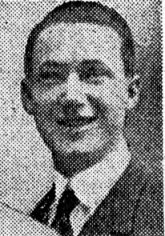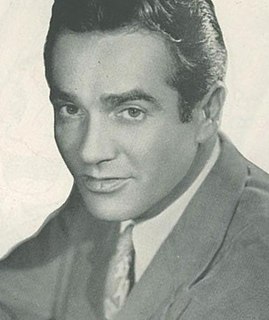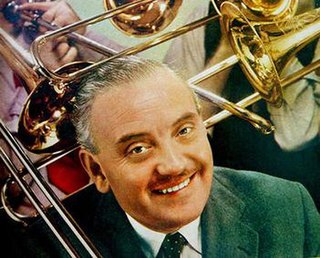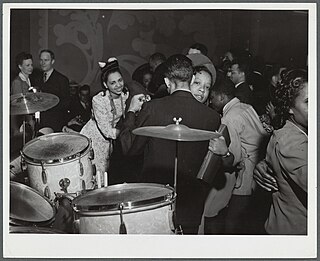Related Research Articles

A jazz band is a musical ensemble that plays jazz music. Jazz bands vary in the quantity of its members and the style of jazz that they play but it is common to find a jazz band made up of a rhythm section and a horn section.

A big band or jazz orchestra is a type of musical ensemble of jazz music that usually consists of ten or more musicians with four sections: saxophones, trumpets, trombones, and a rhythm section. Big bands originated during the early 1910s and dominated jazz in the early 1940s when swing was most popular. The term "big band" is also used to describe a genre of music, although this was not the only style of music played by big bands.
Johnny Dodds was an American jazz clarinetist and alto saxophonist based in New Orleans, best known for his recordings under his own name and with bands such as those of Joe "King" Oliver, Jelly Roll Morton, Lovie Austin and Louis Armstrong. Dodds was the older brother of the drummer Warren "Baby" Dodds, one of the first important jazz drummers. They worked together in the New Orleans Bootblacks in 1926. Dodds is an important figure in jazz history. He was the premier clarinetist of his era and, in recognition of his artistic contributions, he was posthumously inducted into the Jazz Hall of Fame. He has been described as "a prime architect in the creation of the Jazz Age."
Swing music is a style of jazz that developed in the United States during the late 1920s and early 1930s. It became nationally popular from the mid-1930s. The name derived from its emphasis on the off-beat, or nominally weaker beat. Swing bands usually featured soloists who would improvise on the melody over the arrangement. The danceable swing style of big bands and bandleaders such as Benny Goodman was the dominant form of American popular music from 1935 to 1946, known as the swing era. The verb "to swing" is also used as a term of praise for playing that has a strong groove or drive. Musicians of the swing era include Duke Ellington, Benny Goodman, Count Basie, Cab Calloway, Jimmy Dorsey, Tommy Dorsey, Woody Herman, Harry James, Lionel Hampton, Glenn Miller, Artie Shaw and Django Reinhardt.

Lawrence James Shields was an early American dixieland jazz clarinetist. He was a member of the Original Dixieland Jazz Band, the first jazz band to record commercially.

Alcide Patrick Nunez, also known as Yellow Nunez and Al Nunez, was an American jazz clarinetist. He was one of the first musicians of New Orleans to make audio recordings.

Coleman Randolph Hawkins, nicknamed "Hawk" and sometimes "Bean", was an American jazz tenor saxophonist. One of the first prominent jazz musicians on his instrument, as Joachim E. Berendt explained: "there were some tenor players before him, but the instrument was not an acknowledged jazz horn". Hawkins biographer John Chilton described the prevalent styles of tenor saxophone solos prior to Hawkins as "mooing" and "rubbery belches." Hawkins cited as influences Happy Caldwell, Stump Evans, and Prince Robinson, although he was the first to tailor his method of improvisation to the saxophone rather than imitate the techniques of the clarinet. Hawkins' virtuosic, arpeggiated approach to improvisation, with his characteristic rich, emotional, and vibrato-laden tonal style, was the main influence on a generation of tenor players that included Chu Berry, Charlie Barnet, Tex Beneke, Ben Webster, Vido Musso, Herschel Evans, Buddy Tate, and Don Byas, and through them the later tenormen, Arnett Cobb, Illinois Jacquet, Flip Phillips, Ike Quebec, Al Sears, Paul Gonsalves, and Lucky Thompson. While Hawkins became known with swing music during the big band era, he had a role in the development of bebop in the 1940s.

Eugene Bertram Krupa was an American jazz drummer, bandleader and composer who performed with energy and showmanship. His drum solo on Benny Goodman's 1937 recording of "Sing, Sing, Sing" elevated the role of the drummer from an accompanist to an important solo voice in the band.
Illinois, including Chicago has a wide musical heritage. Chicago is most famously associated with the development of electric blues music. Chicago was also a center of development for early jazz and later for house music, and includes a vibrant hip hop scene and R&B. Chicago also has a thriving rock scene that spans the breadth of the rock genre, from huge stadium-filling arena-rock bands to small local indie bands. Chicago has had a significant historical impact on the development of many rock subgenres including power pop, punk rock, indie rock, emo rock, pop punk, and alternative rock.

Jazz music has a long history in Australia. Over the years jazz has held a high-profile at local clubs, festivals and other music venues and a vast number of recordings have been produced by Australian jazz musicians, many of whom have gone on to gain a high profile in the international jazz arena.

George Edward Heath was a British musician and big band leader.
Dutch jazz refers to the jazz music of the Netherlands. The Dutch traditionally have a vibrant jazz scene as shown by the North Sea Jazz Festival as well as other venues.

The origin of the word jazz is one of the most sought-after word origins in modern American English. Interest in the word – the American Dialect Society named it the Word of the Twentieth Century in 2000 – has resulted in considerable research and the linguistic history is well documented. "Jazz" began as a West-Coast slang term around 1912. The meaning varied, but the word did not initially refer to music. "Jazz" came to mean "jazz music" in Chicago around 1915.

A jazz club is a venue where the primary entertainment is the performance of live jazz music, although some jazz clubs primarily focus on the study and/or promotion of jazz-music. Jazz clubs are usually a type of nightclub or bar, which is licensed to sell alcoholic beverages. Jazz clubs were in large rooms in the eras of Orchestral jazz and big band jazz, when bands were large and often augmented by a string section. Large rooms were also more common in the Swing era, because at that time, jazz was popular as a dance music, so the dancers needed space to move. With the transition to 1940s-era styles like Bebop and later styles such as soul jazz, small combos of musicians such as quartets and trios were mostly used, and the music became more of a music to listen to, rather than a form of dance music. As a result, smaller clubs with small stages became practical.

The Club DeLisa, also written Delisa or De Lisa, was an African-American nightclub and music venue in Chicago, Illinois. Located at 5521 South State Street, it was possibly the most prestigious venue in the city, together with the Regal Theater and the Rhumboogie Café, the 800–seat Club DeLisa played a key role in the city's association with jazz, blues, rhythm and blues and soul music. It closed in February 1958, but was re-opened as The Club in 1966.

Bert Kelly was an American musician, who pioneered jazz as a banjoist, bandleader, educator, promoter, night club owner, and night club operator. After professional stints in Seattle and San Francisco, Kelly moved to Chicago in 1914 where he flourished a banjoist, bandleader, and promoter. In 1915 — before the U.S. prohibition — he founded and operated a Chicago speakeasy called "Bert Kelly's Stables," where patrons were introduced to early jazz.
Kelly’s Stables, also referred to as Kelly’s Stable, was a jazz club on Manhattan's 52nd Street in New York City, opened by jazz band leader Bert Kelly.
The Jazz Discography is a print, CD-ROM, and online discography and sessionography of all categories of recorded jazz — and directly relevant precursors of recorded jazz from 1896. The publisher, Lord Music Reference Inc., a British Columbia company, is headed by Tom Lord and is based in Chilliwack, British Columbia, Canada. The initial 26 of 35 print volumes, which comprise the discography, were issued from 1992 to 2001 in alphabetic order. In 2002, The Jazz Discography became the first comprehensive jazz discography on CD-ROM.

William (Bill) Julius Theodore Reinhardt was an American clarinetist, bandleader and the owner of Jazz, Ltd.—the first Jazz club run by a musician in Chicago and one of the longest running Dixieland jazz clubs in the country. He also played tenor saxophone, French horn and sang. Unlike many of the famous jazz musicians that Bill employed in his band, he did not seek fame; he was content with the great success of his nightclub. However, by the 1960s his band did appear on two TV programs.
Kelly's Stables may refer to:
References
- ↑ "Bert Kelly’s Stables" The University of Chicago Library. Retrieved 13 August 2013.
- ↑ Jazz, A–Z, by Peter Clayton and Peter Gammond, Guinness Superlatives (1986) OCLC 15353474